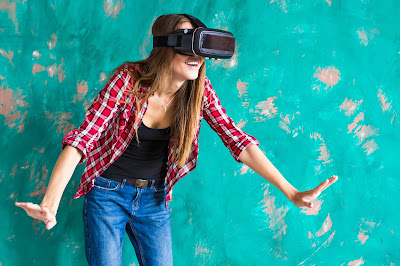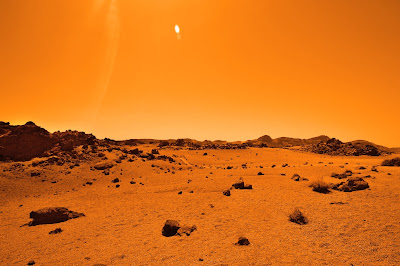It’s a whole new world of artistic possibilities. A Friends’ Preview
Evening at the Royal Academy of Arts introduced me to virtual reality as a new
art form. Virtually Real displays 6 months of project work by 3 Royal Academy students using HTC Vive.
HTC Headset and controls
Each participant at the preview had their own headset and HTC helper. The
headset was a snug and comfortable. It remained firmly in place throughout the
experience. I also had two handsets. They felt very much like Wii game controls. Swiping revealed additional virtual functionality.
First virtual artwork
It took some adjustment to understand that I could move 360 degrees
around the first virtual world as well as forward, back, up and down. At one
point, I felt obstructed by virtual black and white poles. At another point,
the ground cut completely away from underneath me. My brain told me that I
should be falling. I couldn’t see my feet on the floor. My reactions were in slow
motion.
At the end of the first experience, I painted virtual reality objects as
if daubing them with graffiti. They were suspended in the air. I moved to access different sides. My movements must have looked odd to anyone without
a headset.
Virtual Martian world
The second experience of the evening was my favourite. I was transported
into a Martian-type landscape. The sand was blowing in a wind at ground level,
yet I could not feel the slightest breeze. The starry sky above made me stare up in wonder.
I noticed some large blue insect-like creatures moving in a line in the
mid-distance. It was like a scene out of Star Wars or Walking with Dinosaurs.
Next, I became aware of 5 naked human forms dancing just in front of them. They
did not interact with each other, or even show an awareness of each other. I
was like a ghost within the scene - or sometimes within a visible blue cage-like
structure.
I would have been quite happy just admiring the alien landscape. The
changing night sky from day to night fascinated me. I also had music in my ears
cutting me off from the real world. I watched as bone-like structures moved
from the ground into the air and turned into singing mouths. An abstract
painting come to life and sound.
Google Tilt Brush
The final experience involved having a go at virtual
reality painting for myself using Google’s Tilt Brush. I felt like I was back
in my primary school days wielding a large dollop of paint with an overly thick
brush. My aerial artwork was little more than a squiggle. My scribble evolved
into a multi-coloured logo. I tried to do an insect. My admiration for the RA’s
student artists increased. I would need a lot longer than 6 months to reach
even an amateurish level.
Disorientation
The experience was soon over. The headset came off. I felt
disorientated. My brain needed time to catch up. Others had apparently tripped
and fallen afterwards. I suppose some people are more susceptible than others.
I could see that these virtual worlds could become as addictive as online games
- if not more so.
Future possibilities and responsibilties
This technological art is very much in its infancy. It felt immature at times. Inspiration
seemed to come from gaming and science fiction films. No doubt both tools and
artistry will become more refined, leading to greater control and detail in
future. There is much more room for creativity. The experience could be more emotive. Paul Delaroche’s huge picture of Lady Jane Grey’s Execution in
the National Gallery came to mind. That painting is moving in 2D; it could be overwhelming
in virtual reality.
Amber flag. Virtual reality artists will need to explore the medium
responsibly. They should steer clear of, or be ultra-careful with, gruesome or
adult content. There is room for increased interactivity within the picture. It
could be terrifying to find yourself inside a graphic horror scene.
I would build on the experiences that inspired admiration and awe. Perhaps
recreate the landscapes that we know are disappearing in the world? No doubt a
great master or two will emerge and develop the new art form in ways we cannot
even conceive of now. How would such artworks be handed down to posterity? How
do we ensure that any masterpieces will still be accessible as technology
develops?
Back in the Real World
I wandered through the other rooms. Some pieces had been printed in 3D.
They seemed flat. I barely noticed the 2D paintings on the walls. Discounting
waiting time, my experience lasted just under half an hour. Yet I was
disorientated. It would be hard to see a whole gallery in virtual reality.
Maybe we would become more acclimatised?
I was so distracted by my virtual world experiences that I missed my
stop for home in the real world.
Karen Andrews is a freelance French to English translator, transcreator, content writer and editor. She has a strong background in global marketing.
Email Karen for further information via karenanglicityen@gmail.com in French, German or English.




No comments:
Post a Comment